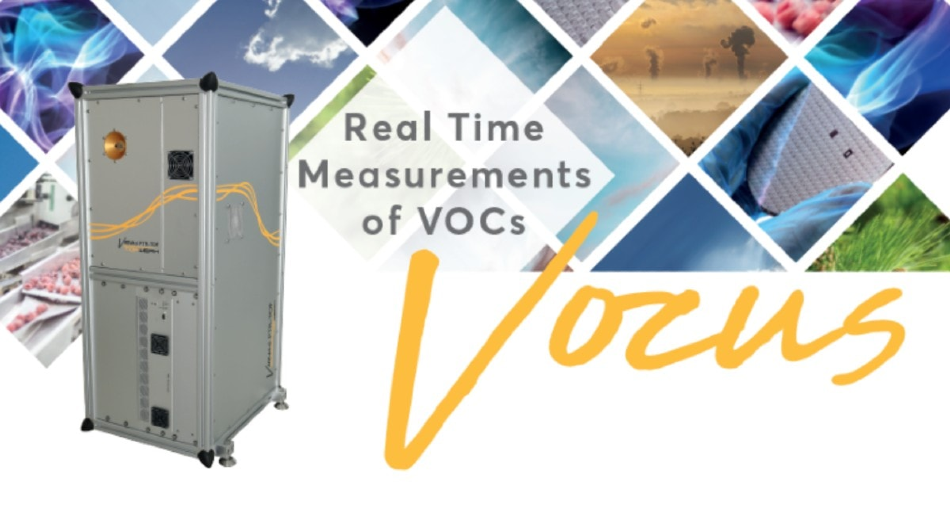Second generation vocus S and 2R raise the bar for PTR-TOF sensitivity
The TOFWERK Vocus S and 2R PTR-TOFs are recognized as the world’s most sensitive analyzers for trace volatile organic compounds (VOCs) – enriching online characterization of complex samples in fields ranging from atmospheric research to disease diagnosis and industrial quality control.

We are very excited to release the second generation of the Vocus S and 2R with VOC sensitivities at near practical limits for even the fastest and most trace measurements.
The upper left panel of the figure below demonstrates an unprecedented sensitivity of >30000 cps/ppb for xylene measured with the Gen2 Vocus 2R – a greater than 3x improvement in the already market leading sensitivity of the Vocus.
The source of this improvement is our new Mag Interface, which maximizes recorded signal levels by transferring ions from the Vocus reactor to the TOF analyzer with the highest possible efficiency. Optimum performance is ensured by our Thuner and Acquility software packages, which auto-adjust all Vocus operating parameters according to mass range of interest, sensitivity, and resolving power.
Improving detection limits and identification of high molecular mass VOCs
The increased sensitivity of the Vocus S and 2R has significant implications for high mass VOCs. These compounds, which often have very low abundances due to low vapor pressures, can be difficult to accurately measure and identify. As demonstrated with the D6 siloxane above, the improved precision and high SNR of the Gen2 Vocus yields more robust measurement of the isotopic distribution, allowing confident identification of high mass compounds based on isotopic distributions even at pptv concentrations.
Measurement configurations to match your priorities
As users of TOF mass analyzers know, there are always trade-offs between sensitivity, mass resolving power, and mass range. For instance, tuning an instrument to optimize sensitivity or resolving power generally lowers the achieved value of the other. Instrument manufacturers quote fixed specifications, but, in practice, scientists adjust instrument performance to balance their needs. Measurements on fast-moving mobile labs may sacrifice resolving power to achieve the required sensitivity; on the other hand, a scientist measuring complex aromas may sacrifice sensitivity in order to measure and resolve the thousands of VOCs that are present across a broad mass range. With the Gen2 Vocus S and 2R these trade-offs become far less significant. Scientists can now make measurements with the highest VOC sensitivity ever available or increase mass range and resolving power while still maintaining sensitivity that exceeds the requirements of most samples. Our control software adjusts all parameters according to your measurement priorities and allows seamless alternation between configurations for different detection scenarios.
The new vocus scout for VOC monitoring in complex environments
Tofwerk is a global leader in mobile mass spectrometry, having deployed instruments to remote field sites on all seven continents and on-board many mobile research platforms, including vans, aircraft and ocean vessels.
Our Vocus Elf PTR-TOF was released in 2019 with an eye on real-time monitoring of VOCs. Its compact architecture and AcquilityTrack software, allow easy installation in monitoring stations or mobile laboratories, with automated reporting of real-time data. Recent measurement examples include long-term monitoring of VOC emission reductions during China’s coronavirus outbreak and mobile measurements to characterize spatial distributions of VOCs near Tofwerk’s headquarters in Thun, Switzerland.
In 2020, we release our more advanced platform for real-time reporting of trace VOCs: the Vocus Scout. Like the Elf, the Scout runs on our AcquilityTrack software to facilitate simple use, long-term autonomous operation, and confident real-time data reporting without post processing. Its robust construction is similarly ready for deployment in challenging environments or any mobile laboratory.
With higher sensitivity (>4000 cps/ppb xylene) and mass resolving power (3500, M/dM) than the Elf, the Scout enters the market as the solution for monitoring of very trace VOCs or monitoring of target VOCs in the presence of complex VOC backgrounds. For instance, the figure below demonstrates the Scout’s ability to resolve isobaric trace VOC ions and separately report each of their concentrations.
The Vocus PTR-TOF is a proton transfer reaction mass spectrometer for sensitive, real-time detection of volatile organic compounds (VOCs) in industrial, laboratory, and field applications.
See the Vocus Product Page for full details, model specifications, and application demonstration.